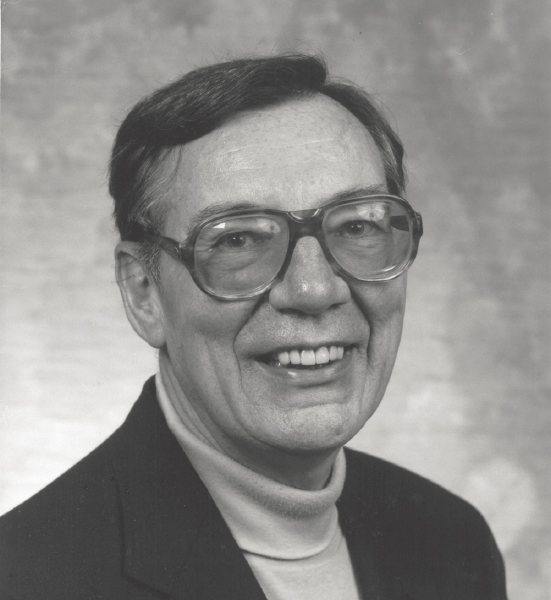
ROBERT PLUNKETT
1919–2019
Elected in 1974
“Contributions to experimental and analytical mechanics to solve noise, vibration, and fatigue problems.”
BY ROGER R. SCHMIDT AND WILLIAM GARRARD
ROBERT PLUNKETT was an internationally recognized authority in vibrations and experimental measurements of mechanical behavior of materials. He passed away March 19, 2019, shortly after celebrating his 100th birthday in Austin, Texas, with family, friends, former students, and colleagues.
Born in New York City on March 15, 1919, Robert was the son of Becky (née Edelsohn) and Charles Plunkett. He entered the Massachusetts Institute of Technology when he was in his mid-teens and received a bachelor’s degree in civil engineering in 1939. He remained at MIT after graduation as a research assistant and instructor until, in 1942, he enlisted in the US Army during World War II. A combat engineer, he landed at Normandy on D-Day+1.
He separated from the Army in 1946 as a major and returned to MIT, where he taught and earned his doctor of science degree in mechanical engineering in 1948. He was then hired as an assistant professor in mechanical engineering at Rice University, until in 1951 he went to work at General Electric Co. as a consulting engineer in vibration and acoustics. In 1960 he accepted a professorial appointment in engineering mechanics at the University of Minnesota and remained there until his retirement in 1988.
During his nearly three decades at the University of Minnesota he was active in teaching and advising at both the graduate and undergraduate levels. He led 16 students through PhD studies (including the first PhD the department awarded to a woman), and was a mentor, role model, and friend to many junior faculty members. He was also a Fulbright scholar in France, Israel, and Italy.
Professor Plunkett was a strong advocate for undergraduate education and “real-world, hands-on” educational experiences for students. He was instrumental in maintaining the quality and relevance of the undergraduate teaching laboratories, and introduced an undergraduate course in composite materials and structures when these were just beginning to be used extensively in the aerospace industry. Over the years, this course has been extremely popular and a version is still taught.
Plunkett became famous for his application of mechanical mobility to the solution of acoustic vibration problems involving large electrical machinery on thick platforms. This pioneering accomplishment led to measurement techniques for acoustic mobility, models for the (acoustic) vibration response of damped systems, methods for modeling bending and torsional waves in inhomogeneous bars, characterization of transient response of dissipative structures, and determination of optimum structural damping. He developed methods for reducing (acoustic) vibrations in foundations and enclosures where rotating or reciprocating machinery is involved. He contributed to noise control for appliances, pneumatic tools, piston rings, and aerospace structures, in addition to fatigue, vibration damping, and stress analysis. He published over 60 research papers on these topics.
During and after his career at the University of Minnesota, Robert was a consultant for over 40 organizations, including GE, Westinghouse, Medtronic, Electric Power Research Institute, Honeywell, Hughes Tool, Hamilton Standard, Ford Motor Co., and the US Department of Defense, including the Navy, Army, and Air Force.
His honors included election to the National Academy of Engineering, designation as an ASME honorary member,
and an honorary doctorate from the University of Nantes in France. He was a fellow of the American Society of Mechanical Engineers, American Association for the Advancement of Science, and Acoustical Society of America, and a member of the Society of Experimental Stress Analysis, American Society for Engineering Education, American Institute of Aeronautics and Astronautics, and Institute of Noise Control Engineering. For ASME he served on the board of governors (1981–82), Roe Medal Committee (chair, 1989–90), and Committee on Investment (chair, 1991–92; vice chair 1990–91). For the National Research Council he served on the US National Committee on Theoretical and Applied Mechanics (1984–88) and the Committee on Marine Structures (1985–88) of the Transportation Research Board.
Robert married Helen Catharine (Katie) Bair on May 11, 1946. They traveled widely, visiting over 100 countries, and were extraordinary hosts when at home. Sunday night dinners prepared by Katie at their home on Lake Owasso in Roseville were legendary for the food and conviviality. Robert’s laugh, once heard, could never be forgotten. He loved teaching and being an engineer, and was never at a loss for words or for an opinion.
Perhaps fostered by his year in the Merchant Marines at age 14 (although accepted to MIT his mother thought he was too young for college) he was happiest being on the water (and snow)—summers sailing and winters cross-country skiing. Many years he and Katie escaped part of the Minnesota winter by sailing in the Caribbean. A highlight was several months sailing from island to island with best friends Paul and Charlotte Paslay.
Robert was determined to hit 100 (he said it was a nice round number) and then was ready to go. His last words to his family before he peacefully closed his eyes: “It’s been a wonderful life and I love you.”
He is survived by three children—Chris (wife Toni), Brian (wife Criss), and Peggy (partner Bill)—as well as five grandchildren and numerous great-grandchildren. Katie, the love of his life, died at age 97 in 2016 after 70 years of marriage.




